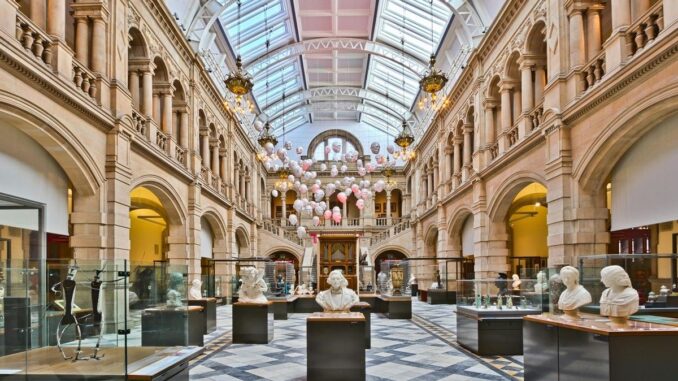
Every place has details that stay with you. Maybe it is the sound of a crowd in a busy square or how the light hits an old wall in the afternoon. These little things make a memory feel alive.
More destinations are now using audio and visual (AV) tools to help visitors notice them. Whether through guided soundscapes or virtual tours, travel is starting to feel more complete.
In this article we explore how these AV tools are reshaping travel – turning tours into layered experiences that engage sight, sound and emotion, both in person and online.
Sensory enrichment in modern exploration
Museums and landmarks are rethinking how they present history. Instead of static exhibits, they now use audio and visual tools to invite people into the story. Visitors experience each space with a stronger sense of presence and connection.
Projection mapping
Old walls and ancient ruins can now serve as living screens. Through carefully designed light projections, they show how a structure once looked or replay key events that took place there. It turns a simple viewing into a short performance where the story unfolds before your eyes.
Directional soundscapes
In a gallery or heritage site, sound zones guide the experience. Step closer to a display and you might hear voices from the past or the natural sounds of a marketplace. The audio shifts with your position, creating a sense of being present in another time.
Interactive displays
Touch-based panels and motion sensors now let visitors explore at their own pace. You can restore a damaged artifact on screen or move through a timeline by gesture. It gives people more control and makes learning feel personal rather than passive.
Classrooms, museums and learning spaces now use advanced AV solutions to create environments that feel alive. These systems blend light, sound and movement in ways that make lessons and exhibits easier to connect with. Learners can sense the mood of a story instead of only seeing it unfold.
The blending of physical and virtual journeys
Audio and visual tools now shape travel in different ways. Some make on-site visits richer, while others bring destinations within reach for people who explore from afar. Together they create a more open and flexible way to experience the world.
-
Enhancing on-site experiences
Technology adds small layers that make real places feel more vivid.
- Augmented Reality (AR) apps can show how a ruin once looked or display stories connected to a landmark. History appears right on top of the present view.
- Wearable audio guides tell the story of a location step by step. Travellers can walk freely and still get the right details at the right time.
- Smart displays and mobile tools tie together maps, sound and images, helping people move around without joining large tour groups.
These features make it easier to explore while staying focused on what is around you.
-
Expanding virtual exploration
Travel does not always require a ticket or a plane ride.
- 360-degree videos with spatial sound can bring you into the middle of a festival or onto a quiet trail in the mountains.
- Online tours let travellers preview places before a trip or visit sites that may be too far or fragile to reach.
- Some cultural centres now stream guided tours, giving people access to art, history and nature wherever they are.
-
Supporting sustainable discovery
Virtual travel also helps protect destinations. It answers the same curiosity that drives tourism while reducing the environmental cost. People can still learn, explore and connect, even when the experience takes place through a screen.
Amplifying cultural connection and narrative
Travel has always been about people and the stories that give each place its own character. With the help of new audio-visual tools, those stories can now reach farther than ever without losing their authenticity.
Here’s how many communities are using these tools in their own way:
- Capturing their traditions. From a town known for handwoven cloth to a village famous for its music, locals can now record their art in crisp sound and colour, keeping every rhythm and gesture alive.
- Sharing across digital spaces. These clips and recordings appear in online museums, virtual exhibits or guided experiences, giving people a chance to explore a culture from their own homes.
- Supporting local life. A simple video can spark curiosity that turns into travel. Visitors come, meet the artists and help sustain small family businesses and cultural centres.
A single recording can bridge generations and places. Through it, a craftsperson shows how a pattern is made and an elder passes a story forward to listeners far from home.
Technology stays in the background. What remains are the voices, the laughter and the history that link people wherever they may be.
Final thoughts
Each destination speaks in its own rhythm. Modern AV tools help travellers pay closer attention to the details that define it – the tones, the spaces and the light that shifts through the day. These small elements give a visit its shape and meaning.
When the trip ends, those details do not fade easily. A single sound or story can bring the memory back in full. What begins as exploration turns into understanding and that connection lasts far longer than the journey itself.
Author Bio:
Edrian Blasquino is a college instructor turned wordsmith, with a passion for both teaching and writing. With years of experience in higher education, he brings a unique perspective to his writing, crafting engaging and informative content on a variety of topics. Now, he’s excited to explore his creative side and pursue content writing as a hobby.
Photo by Michael D Beckwith from Pexels




Be the first to comment